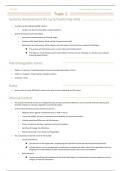Summary
Summary of notes
- Course
- DLA 242
- Institution
- Stellenbosch University (SUN)
Whether you're a business professional aiming to optimize your company's financial operations or a student seeking comprehensive insights into Acumatica's accounting capabilities, this DLA 242 summary is your go-to resource. With clear explanations, practical examples, and a focus on the intricacie...
[Show more]



